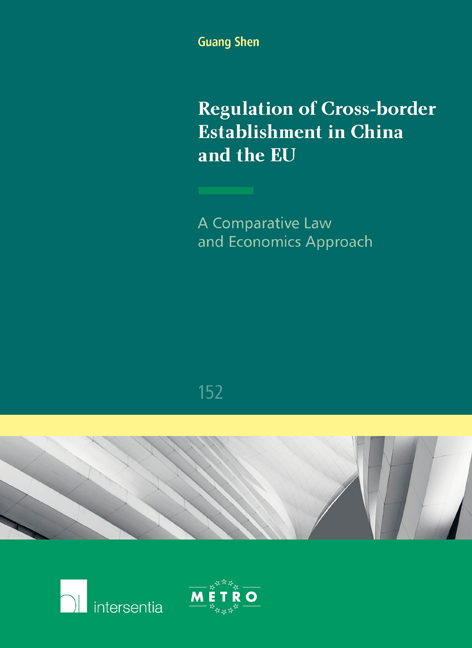Book contents
- Frontmatter
- Acknowledgements
- Contents
- List Of Abbreviations
- Chapter 1 Introduction
- PART I LEGAL ANALYSIS
- PART II THEORETICAL FRAMEWORK
- PART III ECONOMIC EVALUATION
- Chapter 6 An Economic Analysis Of Regulation Of The Inter-Provincial Establishment Of Companies In China
- Chapter 7 Regulation Of The Inter-Provincial Establishment Of Companies In China: Learning From Europe?
- Chapter 8 Conclusions
- Valorisation Addendum
- Bibliography
- Curriculum Vitae
- Ius Commune Europaeum
Chapter 7 - Regulation Of The Inter-Provincial Establishment Of Companies In China: Learning From Europe?
from PART III - ECONOMIC EVALUATION
Published online by Cambridge University Press: 13 December 2017
- Frontmatter
- Acknowledgements
- Contents
- List Of Abbreviations
- Chapter 1 Introduction
- PART I LEGAL ANALYSIS
- PART II THEORETICAL FRAMEWORK
- PART III ECONOMIC EVALUATION
- Chapter 6 An Economic Analysis Of Regulation Of The Inter-Provincial Establishment Of Companies In China
- Chapter 7 Regulation Of The Inter-Provincial Establishment Of Companies In China: Learning From Europe?
- Chapter 8 Conclusions
- Valorisation Addendum
- Bibliography
- Curriculum Vitae
- Ius Commune Europaeum
Summary
Introduction
Chapter 6 showed that local governments in China sometimes compete with each other to attract investment by providing more lenient rules on business establishment. In some cases this competition leads to a race to the bottom, but in other cases it results in learning effects. Of course, competition among local authorities also occurs in other federal jurisdictions, such as the EU. Considering the development of the internal market presented in Chapter 3, this chapter compares China with the EU, in order to see to what extent the EU can be a source of inspiration for China.
The EU and China may be incomparable, since the differences between these jurisdictions appear very distinct. One major difference relates to the institutional features of the European and Chinese legal regimes, which will be elaborated on in this chapter. Moreover, China has its own problems to establish a law-based order: ‘a low level of legal consciousness; the lack of a robust civil society; the enduring influence of paternalistic traditions and a culture of deference to government authority; the fallout from the unfinished transition from a centrally planned economy to a market economy;’ and so on. Therefore, we should be aware of the limitations of comparing China with the EU, (due to the unique situation in China).
This chapter will focus on the particular institutional features of the European and Chinese systems, in order to find out whether China can learn something from the EU experience. Specifically, this chapter will point out how the differences in institutions in China and the EU influence the formation of barriers to freedom of establishment in these jurisdictions. Moreover, close attention will be paid to how these differences impact on choosing solutions to these obstacles.
Comparative law and economics will be employed in the analysis. Combining the analytic tools of these two disciplines, this methodology can serve the purpose to better see the reasons for existing provisions and institutions and of their changes and development. This chapter starts by presenting how this approach deals with the comparison of legal systems.
Comparative Law and Economics: The Importance of Considering Institutional Differences in Comparative Study
Comparative law and economics adopts a comparative approach and takes into account local institutional environments. The subject of comparative law and economics is a comparative analysis of various legal rules embedded in different institutional frameworks.
- Type
- Chapter
- Information
- Regulation of Cross-Border Establishment in China and the EU , pp. 245 - 254Publisher: IntersentiaPrint publication year: 2016

